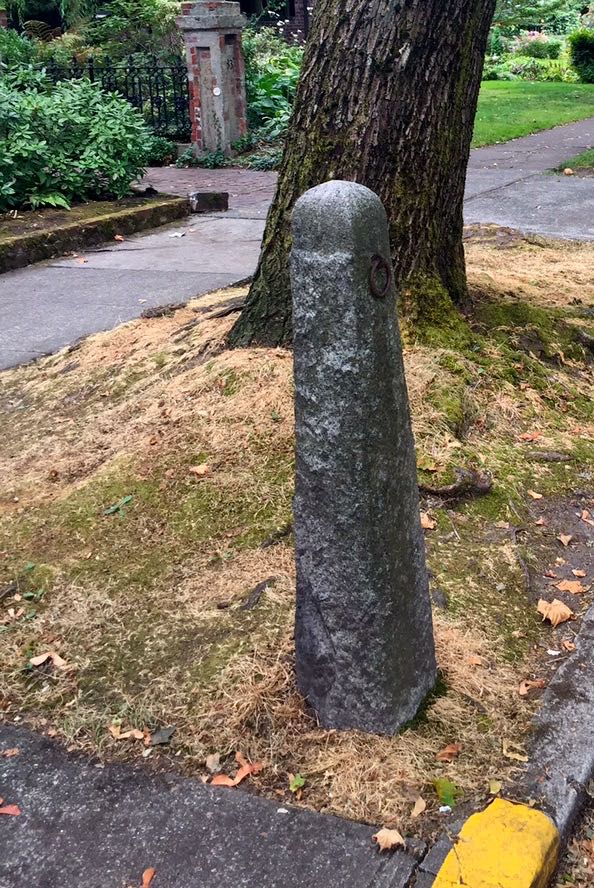Like cats, many quarries have multiple lives, or at least continue to be used long after people have pulled out stone for buildings. My most recent reminder of this was an article in one of Seattle’s local newspapers. The story described how the Index quarry, which Swedish immigrant John Soderberg opened in 1904, had been purchased and protected by the local rock climbing community.
The Index granite, technically a granodiorite, was an important building material in Seattle in the early part of the twentieth century. Soderberg took advantage of the proximity of the Great Northern Railway tracks to ship the stone. It went primarily into curbs and foundations, including my favorite building in Seattle, Smith Tower, but like many a local stone, its luster soon faded, other stones came into the market, and quarry closed down by the mid 1930s. And then the quarry was forgotten until rock climbers discovered it as a great climbing area close to Puget Sound.
Hundreds of climbing routes were put up over the years, much on private land, as well as some in Forks of the Sky State Park. Luckily for the climbers, the private owner, as well as the state parks department, were supportive of the climbers but that support may not have lasted so the Washington Climbers Coalition decided to buy the climbing wall site. On August 25, they completed the purchase of the property and named it the Stimson Bullitt Climbing Reserve.
This is not the only adaptive reuse of abandoned quarries. While working on my book, Stories in Stone, I came across several similar sites. The great granite quarry of Quincy, supplier of stone for the Bunker Hill Monument and numerous structures on the east coast, is also a favorite urban climbing area.

Perhaps the most famous ex-quarry is the one that starred in the movie Breaking Away. After the quarry flooded, it became a popular swimming site. When Breaking Away came out, so many people sought out the quarry that the owners regretted that they ever let the filmmakers shoot there. Access to the quarry is now discouraged, prohibited, and forbidden.

Portland, Connecticut’s fabulous brownstone quarry also flooded, initially when the nearby Connecticut River overflowed into 200-foot-deep hole. Later, a hurricane pushed water back into the quarry and closed it permanently. The property had been slated for development–the plan called for cutting a channel to the river and opening a marina–but then the real estate market crashed. The city of Portland bought the property in 1999 and it was designated a National Historic Landmark the following year. At present, the quarry and site have been opened for a variety of adventure activities, including snorkeling, mountain biking, and zip lines. I am not sure such use truly honors the people who worked the quarry and supplied stone for buildings from Boston to San Francisco but it is a creative use of the land.

P.S. Just got a short note from Dave Tucker at NW Geology Field Trips that reminded me of one other swimming pool quarry. Here is what Dave wrote: “The public pool in Tenino, WA, occupies the old quarry south of downtown. It is closed for the season now. Some water runs through a pipe above the quarry to form a waterfall into the pool. I talked with a local high school kid who was sneaking a smoke by the pool, he said it is ‘hundreds and hundreds of feet deep’. I thought he was just smoking tobacco, but after that comment, not so sure. Just east of the pool area is a stack of big sandstone blocks with splitting holes visible on the edges. All stacked up to form a maze and play area.”
 In fact, I know of two stepping stones, the place where you would step out of your carriage and onto a raised block of stone. One is on Capitol Hill at Fourteenth Ave E. and E. Valley St., on a street known as Millionaire’s Row. This stepping stone stood in front of the house of Elbridge Amos Stuart, the man who started the Carnation Evaporated Milk Company. They’re the ones with the famous slogan about contented cows. The second is just north on the NW corner of Fourteenth and Aloha St.
In fact, I know of two stepping stones, the place where you would step out of your carriage and onto a raised block of stone. One is on Capitol Hill at Fourteenth Ave E. and E. Valley St., on a street known as Millionaire’s Row. This stepping stone stood in front of the house of Elbridge Amos Stuart, the man who started the Carnation Evaporated Milk Company. They’re the ones with the famous slogan about contented cows. The second is just north on the NW corner of Fourteenth and Aloha St. Regarding hitching posts, the ones I know of are just south on Fourteenth, on the west side of the street. One is at Fourteenth and Roy St and the other just house north. Both the posts and steps look to be made of Index Granite, one of the local building stones used in the late 19th and early 20th centuries in Seattle.
Regarding hitching posts, the ones I know of are just south on Fourteenth, on the west side of the street. One is at Fourteenth and Roy St and the other just house north. Both the posts and steps look to be made of Index Granite, one of the local building stones used in the late 19th and early 20th centuries in Seattle.

